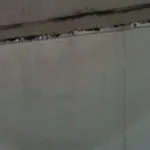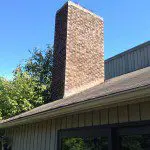31 Jul 2013
How We Make a Custom Chimney Crown
If you want to know how we create a new chimney crown you will want to watch this video.
The homeowner in Barrington Hills, Ill., didn’t really think about the chimney until they noticed leaking on the inside of the fireplace. A closer look revealed a deteriorated chimney cap. The original chimney was faulty—it did not have a proper overhang. This allowed water to work its way down inside the chimney, causing substantial damage to the chimney cap as well as the surrounding brick on the fireplace.
We created a new custom-fit chimney crown out of concrete. The first step was to construct the wooden forms around the top of the brick fireplace. When secure, workers then poured the concrete. Metal rebar ensures that the concrete has a secure hold to the fireplace. A lip on the concrete keeps water flowing in the right direction – away from the fireplace.
Once we had the chimney crown securely in place, mortar joints on the fireplace were ground out to ensure a good bond with the new mortar. Damaged bricks were replaced and the entire chimney was tuckpointed. The final result is a chimney that looks brand new and will last another 2o years.
Even if your home is newer, improper installation of chimney caps can quickly deteriorate your brick. Make it a habit to check your chimney every few years for signs of deterioration. Efflorescence, cracks in the chimney crown and chipped mortar are a few of the signs to look for.
Questions about your fireplace? Give us a call at 708 388 2871.

Saturation Leaks
It may surprise you but masonry is not entirely waterproof. Brick does absorb water. When water passes through or absorbs entirely into the porous surface of a masonry wall to the extent that moisture finds its way into your living space it is called a saturation leak.
Saturation leaks don’t show up every time it rains. That’s because light rain won’t provide enough moisture for the masonry to become saturated and transfer completely through the wall.
Saturation leakage becomes a problem when the water shows up in some occupied or living environment, causing noticeable damage to ceilings, walls or floors. Staining is more often the sign of a saturation leak, rather than water drips or puddles on a floor. Efflorescence or a powdery white substance also appears with saturation leaks. If under wallpaper, efflorescence will give a bumpy like appearance. Paints will eventually blister and crack if efflorescence is present on the wall.
A common area where saturation leaks are found is where the chimney passes through the roof. However, whenever water can run down or moisture is held against a masonry wall (snow) there is a possibility for saturation leaks. Look for failed gutters or downspouts that may be streaming water onto the masonry.
Problem masonry areas can be treated with a water-repellant sealant that reduces the porosity of the masonry. Consult a tuckpointing or masonry professional to determine the right sealant for your building.
Void Leaks
Leaks caused by stress cracks, holes, or missing mortar can sometimes look similar to a saturate leak. Exterior walls should be inspected for problems that could cause or contribute to a saturate leak. It is not uncommon for leaks to have multiple causes. Unlike a saturation leak, void leaks usually occur almost every time it rains. Water streams are visible running down a wall or spread out from a center point of origin. These leaks are usually isolated to a single area.
Leak diagnosis is no easy task, but experienced masonry professionals can help identify problems and find solutions. Shamrock Tuckpointing can keep your Chicago masonry buildings free from leaks.
10 Sep 2012
Chimney Leaks Check List

When talking to a tuckpointer about chimney leaks you may be asked how old the chimney is, what materials were used to build the chimney and how it was constructed. These three variables can reveal potential problem areas. The average homeowner may not know the answers but with a physical inspection, a tuckpointer can find out quick enough.
Check chimney materials
☑ The chimney crown is often an area where leaks can occur, especially if it is made of mortar rather than concrete. Mortar is not as strong as concrete and can absorb water as it deteriorates over time.
☑ The kind of brick and mortar used in the chimney is also a factor. Soft, porous brick is more likely to leak. Mortar mixed with too much sand can actually soak up water. Water repellant products can limit the impact and prolong durability.
☑ Chimney flashing is used in the area where the chimney and roof line meet. Flashing requires two layers of sheet metal. One layer covers the sides of the chimney and the other is embedded in the mortar joints (counter flashing) then folded down for further protection against moisture.
Check chimney condition
☑ Look for crumbling or missing pieces on the chimney crown. Structural damage needs immediate attention. Small cracks in the crwn can often be repaired with a sealant.
☑ Rainfall can gather in the flashing area causing leaks through the joint. This can be repaired with a sealant and mesh fabric to make the joint stron enough to repel water.
☑ For large cracks in the brickwork, tuckpointing with new mortar is recommended.
Chimney leaks can cause damage to a home. Understanding the problem is the first step to keeping your Chicagoland home in good condition. Finding someone who can repair the problem is essential and prudent.


